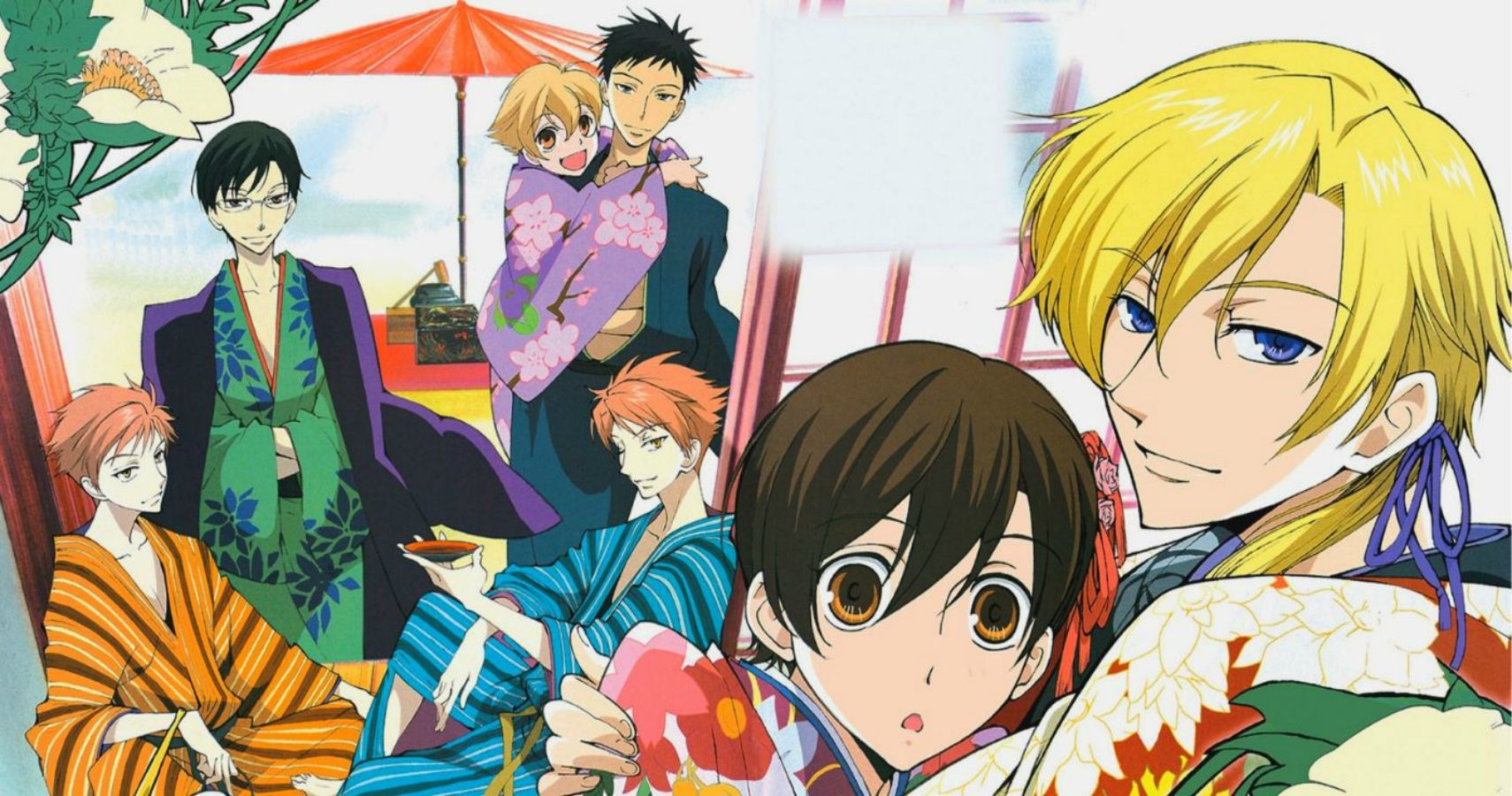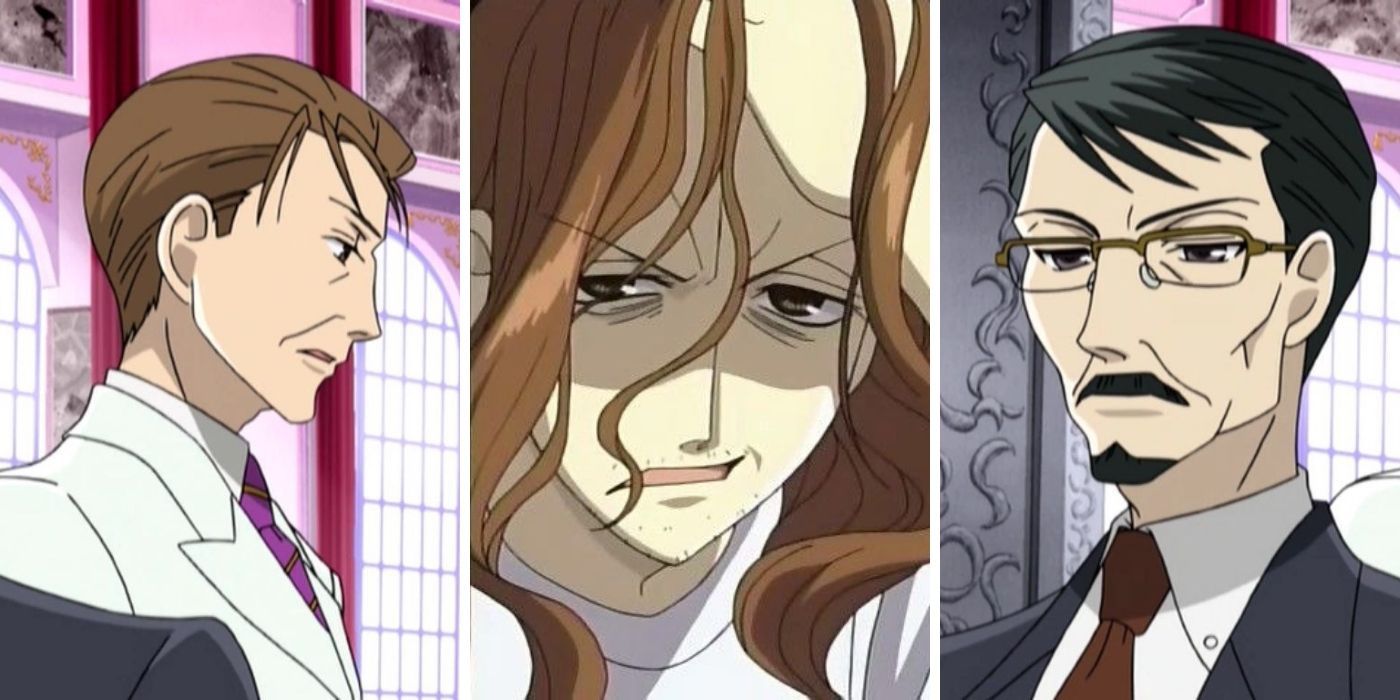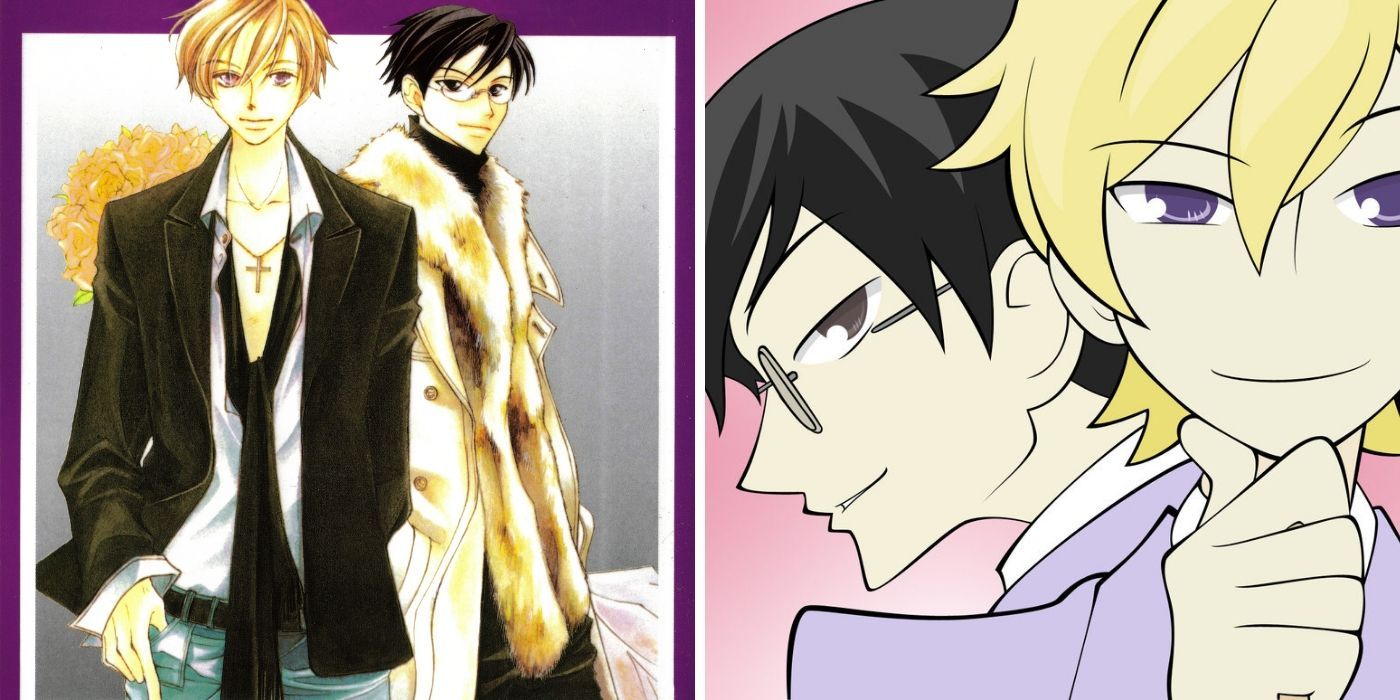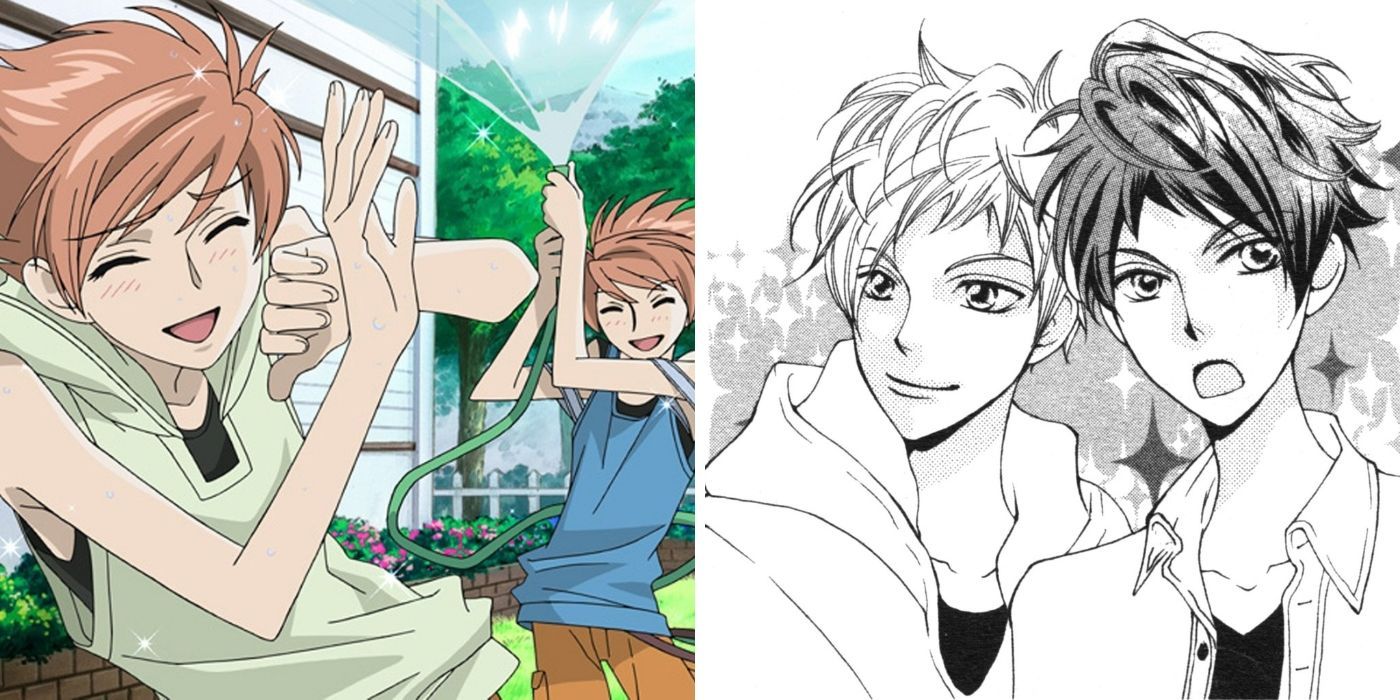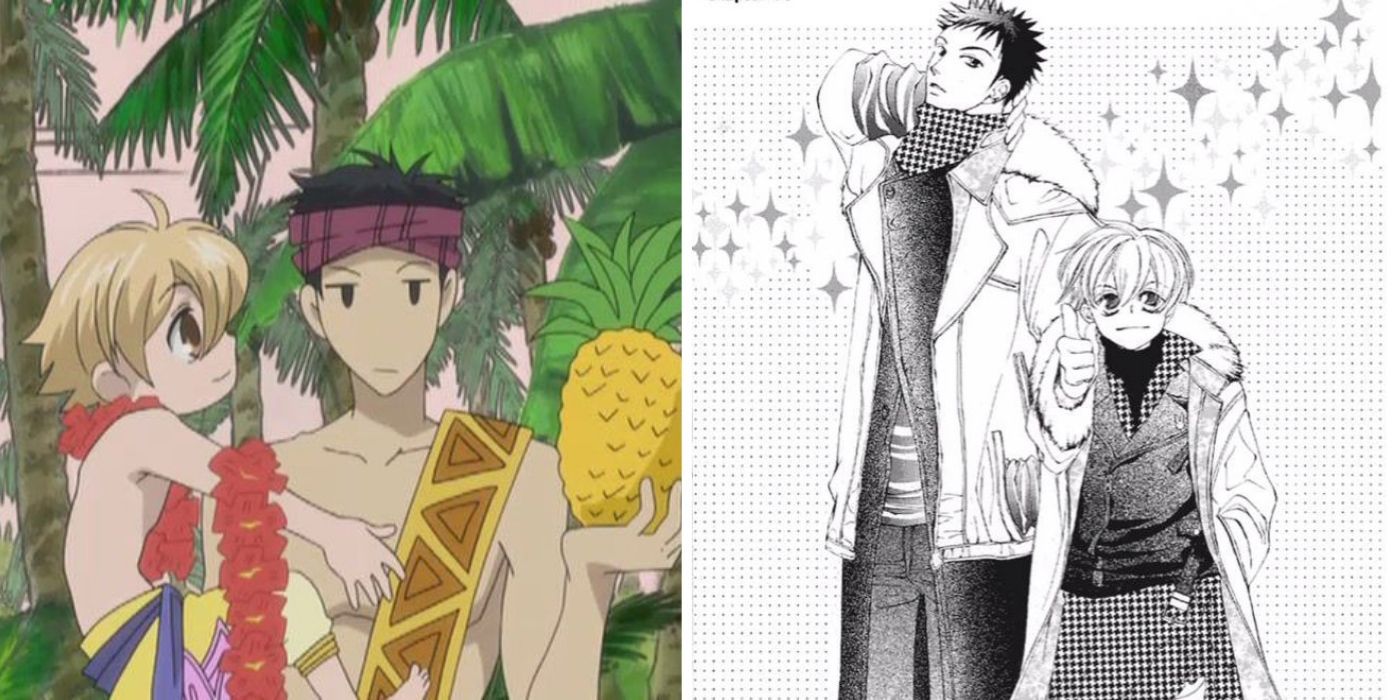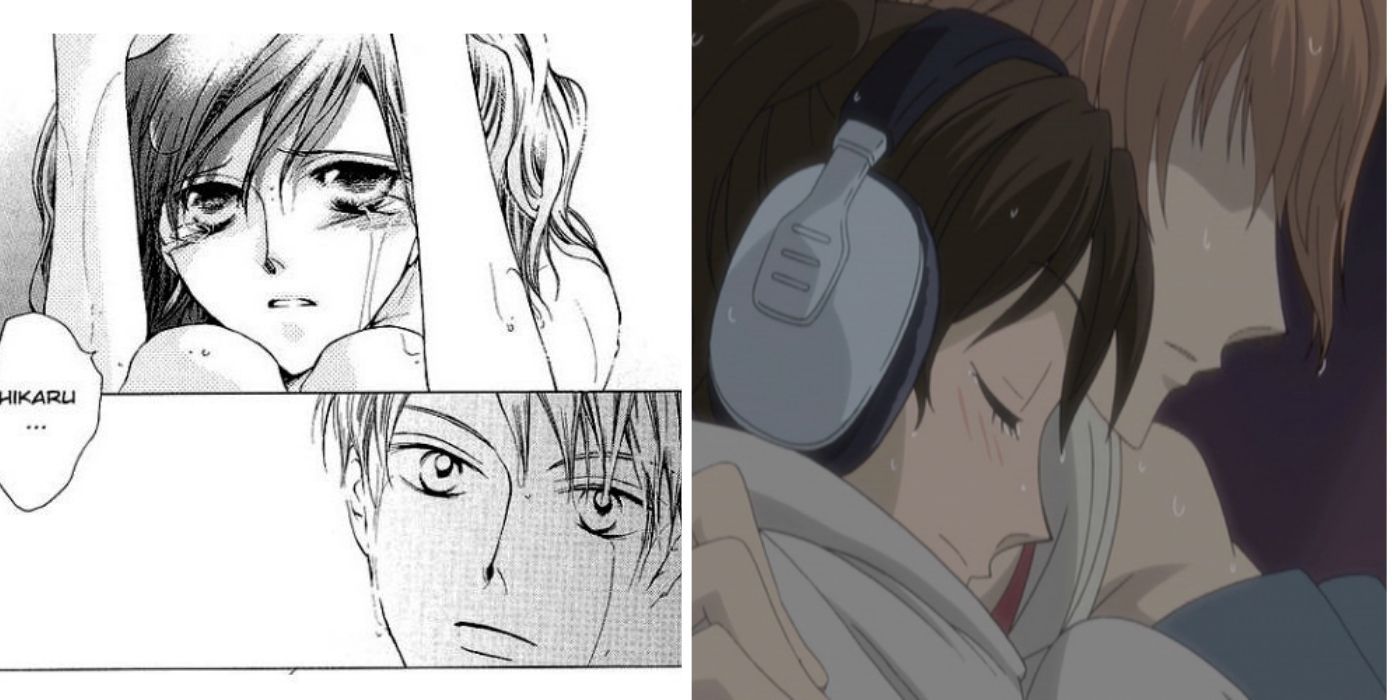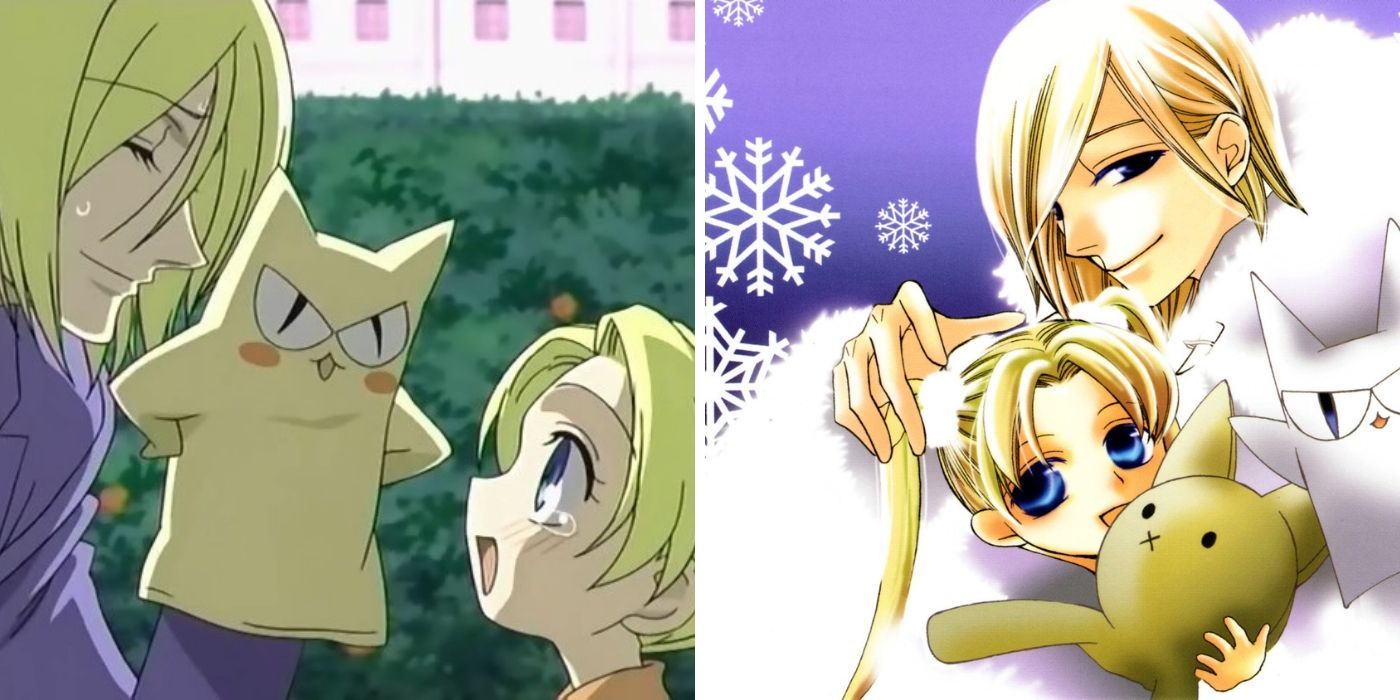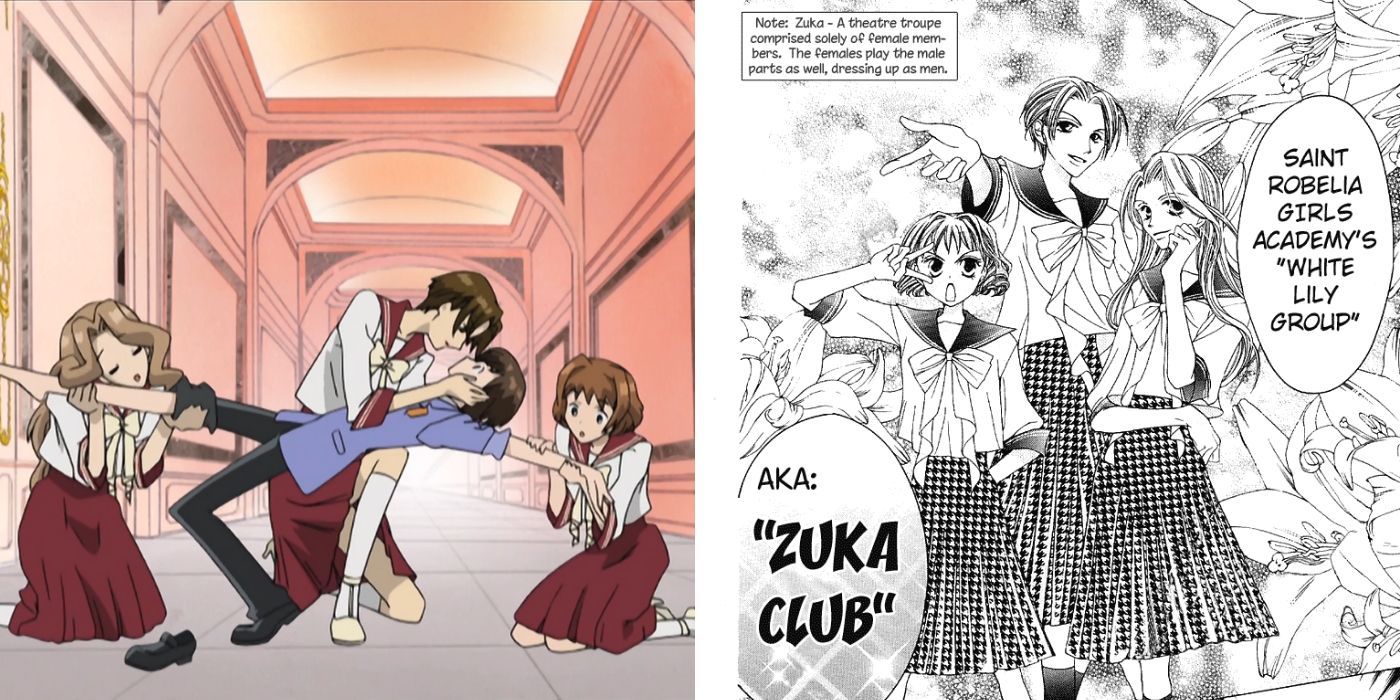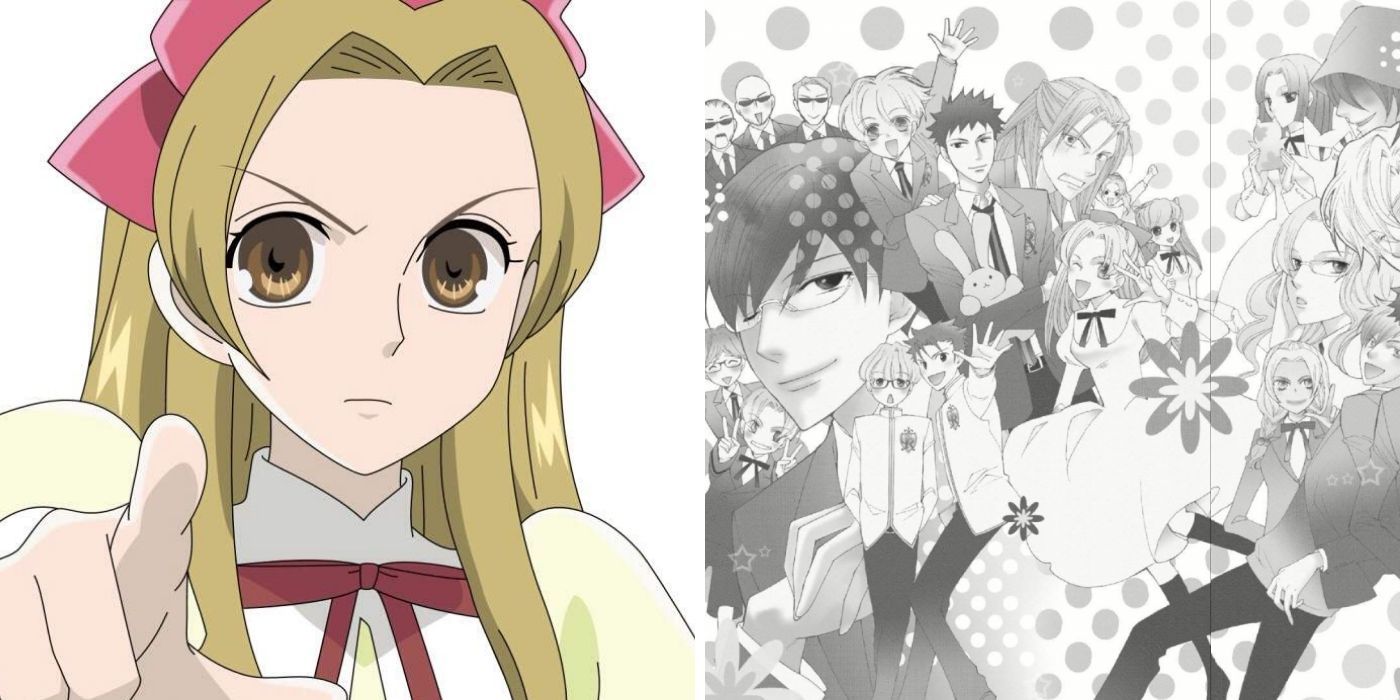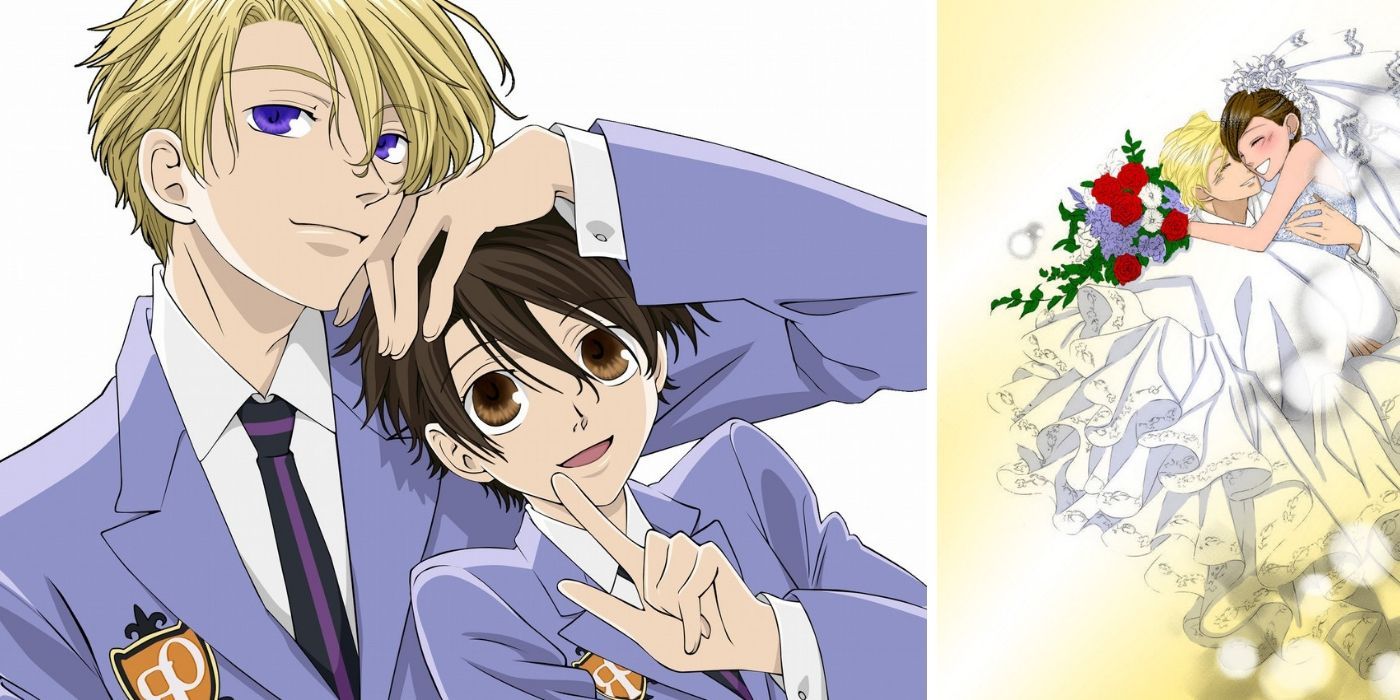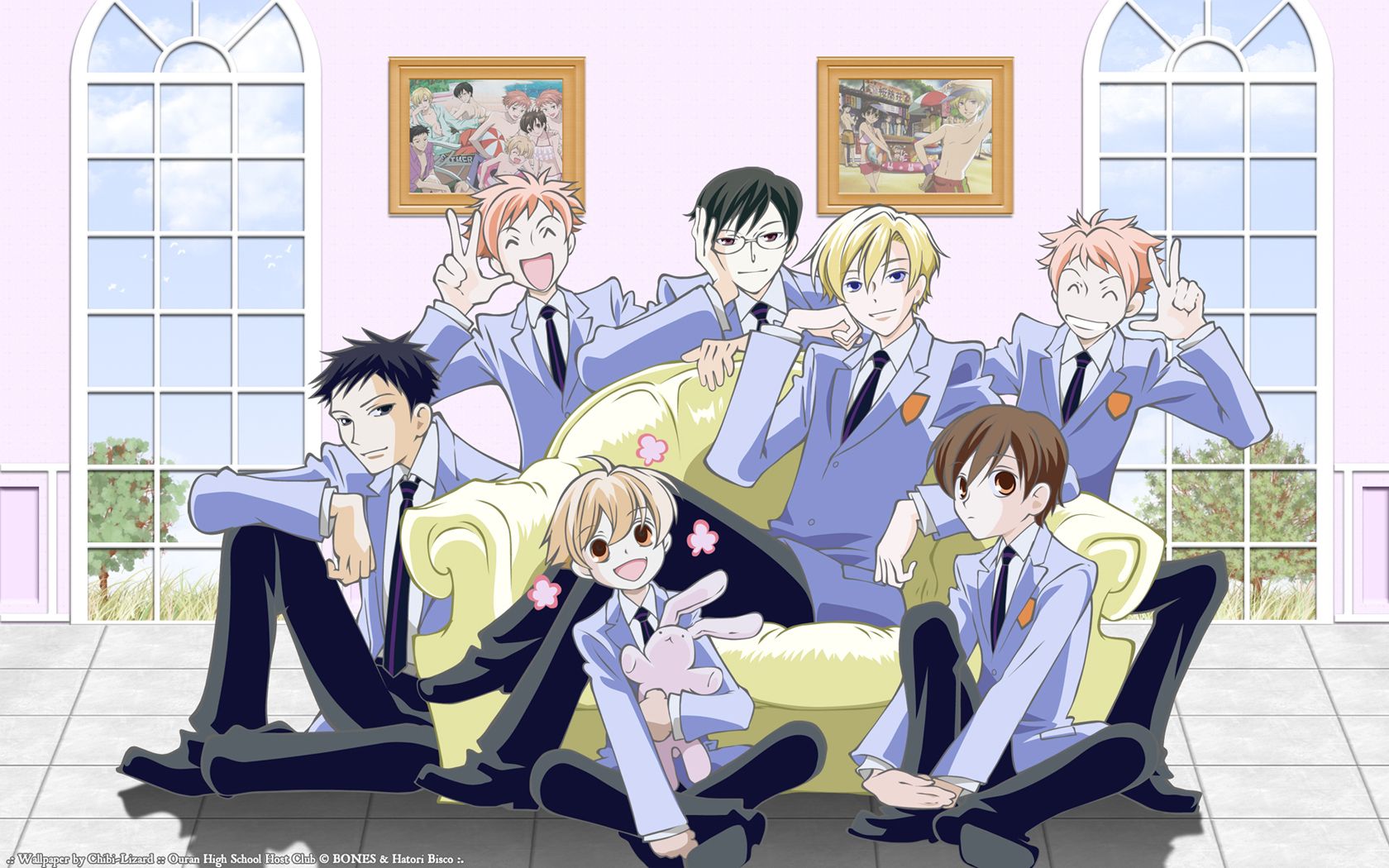Ouran High School Host Club (Hatori Bisco, 2002-2010, Studio Bones 2006) is the almost-perfect parody of every shoujo trope, as well as a bunch of shonen clichés. It follows the adventures of Haruhi Fujioka, a modest, overworked, and apathetic student that has won a scholarship to study at the ultra-elite Ouran High School. On Haruhi’s first day, she manages to contract a massive debt to Ouran’s Host Club, and she is forced to join them and entertain their clients, presenting as male. These are the 5 best and worst relationships of the series.
10 Worst: The Daddy Issues At The Heart of the Club
Let’s start at the beginning: Haruhi, Tamaki, and Kyouya have terrible fathers, and not even the thick layer of comedy can disguise that. Kyouya’s father is successfully grooming his children as cold-hearted business sharks, Haruhi’s dad let her fend for herself since age 6, arriving home late and drunk often enough that her child thought of that as normal, and Tamaki’s father hid his son and his sick mom for most of his childhood for “family honor” reasons.
9 Best: Tamaki and Kyouya’s Origin Story
Tamaki and Kyouya embody every single hot and cold archetype ever recorded in TV Tropes, but what is interesting is how their story arcs criss-cross each other in a perfect mirror pattern. Kyouya starts as the weakest member of a large family, aching with ambition, while Tamaki is in a relatively powerful position within his own family, having been newly recognized as the sole heir to the Suoh hospitality empire.
Kyouya ends his arch in complete control of his family’s business, which he would have never dared do had he not met Tamaki. Thanks to his strategic vision and plotting, Tamaki is able to reunite with his mother and create a loving family of his own. Yes, both the manga and the anime are loaded with between-the-lines unrequited love from Kyouya to Tamaki, but Kyouya never lets this distract him from his goal, and Tamaki never uses it against him.
8 Worst: Hikaru and Kaoru Codependence Mambo
And moving from daddy issues to brotherly problems, these two are a textbook example of co-dependency. Unlike the other Host Club male members, they don’t come from a terribly stiff family, and they are not even the heirs. Their parents love them and encourage them, and they have freedom, money, and each other, which is what makes their storyline particularly difficult to follow.
Basically, Hikaru falls in love with Haruhi, and Kaoru, thinking that he is in love with her too, tries to relinquish her to his brother. Haruhi doesn’t like either of them as anything else than friends, which makes this plot more about learning to share and acknowledging your individuality than about romantic love. It is one of the most frustrating plotlines of the series.
7 Best: Mori and Honey No Drama Dorama
Mori and Honey are the eldest members of the Host Club, and they tend to stay in the background, watching the others and doing their own things, which comprise martial arts and delicious French pastries. As cousins issued from a feudal line, Mori technically owes fealty to Honey, but the care and respect come naturally to both of them. The cousins know and love each other like honorable samurai, and this love and knowledge is translated as total acceptance of everyone in the Club. Besides, they are hilarious to watch in every panel and scene, they bring the fun to the Club’s dysfunction.
6 Worst: The Hikaru/Haruhi Shipwreck
This entry is probably going to light the ire of a few fans, but even they must admit that this ship was destined to strike a massive iceberg. Hikaru Hitachiin, the meaner twin, falls hard, fast, and first for Haruhi and goes through a very hormonal phase where he screams at everyone, breaks up with his twin brother, pretends to be sick to avoid confronting life, and finally dyes his red hair black. He also declares his love to Haruhi, challenges Tamaki to a duel, and behaves like a very well-rounded behind for three whole issues—three anime episodes, more or less. It goes on forever, and miraculously nobody kills him by the end of that arc. The only decent thing he does—and that’s only because Tamaki screams bloody murder at him—is to try to comfort Haruhi when she’s caught in the middle of a thunderstorm.
5 Best: Nekozawa and Kirimi’s Scary Kitties Stories
Nekozawa, 18 years old, scion of his cat-loving, disturbingly militarized Russian family, resident Ouran gothic and president of the Black Magic club, wants his little sister Kirimi to love him. The main issue is that Kirimi is four years old, and, like all four years old do, is scared of darkness, abyss-green hair, and cats larger than she is. She’s also a huge fan of reverse harem mangas. This is clearly a case for the Host Club!
With the enthusiastic help of Tamaki and Renge, they will help Nekozawa get over his fear of the light and get Kirimi to accept that his brother is a lovable freak. The reason why this is one of the best relationships in the entire Host Club is because both siblings work hard to meet each other in the middle, despite the age difference, and it only takes them one single episode/half an issue.
4 Worst: The Zuka Club Versus Host Club Storyline
Over the course of two episodes, we get to meet the Zuka Club, the leaders of the Performing Arts Club of Lobelia Academy. Lobelia Academy is Ouran’s academic rival, and also the school that Haruhi’s mom attended, which, despite her total lack of performing talent, makes her a legacy student and a very attractive recruit for the Zuka club. The actual reason for their persistence is that Benibara has a crush on Haruhi and will do anything to make out with her.
This storyline has not aged well. All-girls Lobelia Academy is depicted as a frenzy of fangirls adoring of their Queen Bee, Benibara. Benibara is the most predatory character to ever appear in Ouran, and this is a series that features an ambiguous pretend rape in its fifth episode. Unfortunately, the characterization and the very bad feminazi iconography skids from a parody of the all-girls Japanese school stories into harmful stereotyping of lesbians, sororities, and powerful women. Yes, these two episodes have their funny moments, but even back in 2011 the Ouran live-action dorama wisely skipped this plotline.
3 Best: Renge and Kyouya, Impresarios Extraordinarios
Another example of a great character arch. Renge first appears an insane otaku obsessed with otome visual novel stereotypes. She’s super duper into Kyouya, because he looks just like her favorite visual novel boyfriend, and she immediately tries to fit the rest of the Host Club into the same romance sim mold with no regard for their actual personalities. Kyouya ends up breaking her camera and her heart, but she picks herself up very quickly.
Through the series, she goes from being an otaku recluse to the charismatic leader of the Host Club clients, an enthusiastic supporter of Tamaki’s plans, a hilarious breaker of the fourth wall for our benefit and even a part-time child entertainer at a mall. She also takes over the Host Club magazine and most of the merchandising rallies the student body for different events and organizes Halloween. By the end of the series, she and Kyouya regularly discuss Host Club projects, and her insights as an outgoing, intelligent market expert become invaluable to him. Thanks to her informal partnership with the Host Club, she becomes an amazing businesswoman in her own right.
2 Worst: Tamaki and Haruhi’s Fairytale Ending (in the Manga)
There is nothing wrong with Tamaki and Haruhi, as characters, ending up together. The seeds were planted early, the character development makes sense, and this couple fits perfectly into the Shoujo Manga pattern of female protagonist ending up with the princely character.
However, there is a big structural issue with Haruhi and Tamaki—or anyone else, for that matter—closing the series with such a cliché, because the series started out as a fourth-wall breaking parody of these clichés. It is disappointing that Haruhi, a complex, bisexual liminal character that moves effortlessly between worlds and whose main motivation is to become a lawyer like her mother, gives that up to marry Tamaki, a very lovable rich heir.
Also, there is no mention of her career in the author’s final words, though the job of all the male members of the Host Club are described). What she gets at the end is not quite what her character wanted at the beginning, but what Tamaki wanted; his own imagine-spot. This ending, in the manga, kind of turns Haruhi into a prize and not a complete character, which is very sad. The anime’s ending was much more satisfying; at the final dance, they hint heavily at an eventual Tamaki-Haruhi ending, but the final stills are of Haruhi’s eyes, lit up with the Ouran fireworks and bright with new and unexplored possibilities
1 Best: The Host Club Ensemble
Okay, so that last sentence was a poetic lie; the last still of the anime is of the whole Host Club watching the fireworks together. It is a beautiful ending tied together with an entire classical orchestra where each instrument shines for a moment before joining the melody for a spectacular finale. Throughout the anime, each character had a specific instrument associated with them, so this final music piece is incredibly intentional.
At its heart of hearts, Ouran High School Host Club is a love letter to the pitfalls of shoujo manga and to its hilariously flawed characters. Hatori Bisco’s brilliance comes from taking the main flaw of each individual character and transforming it into an asset to the group: Tamaki’s delusional daydreams create the Club, Kyouya’s frustrated ambition propels it forward, Hikaru and Kaoru’s dissent acts as a mirror of the other members’ growing pains, Mori and Honey’s archaic values set the tone for the hosts’ loyalty and moral code, and Haruhi’s relative poverty and stark realism shines a light of humor into the absurdity of Ouran’s ultra-rich environment.

